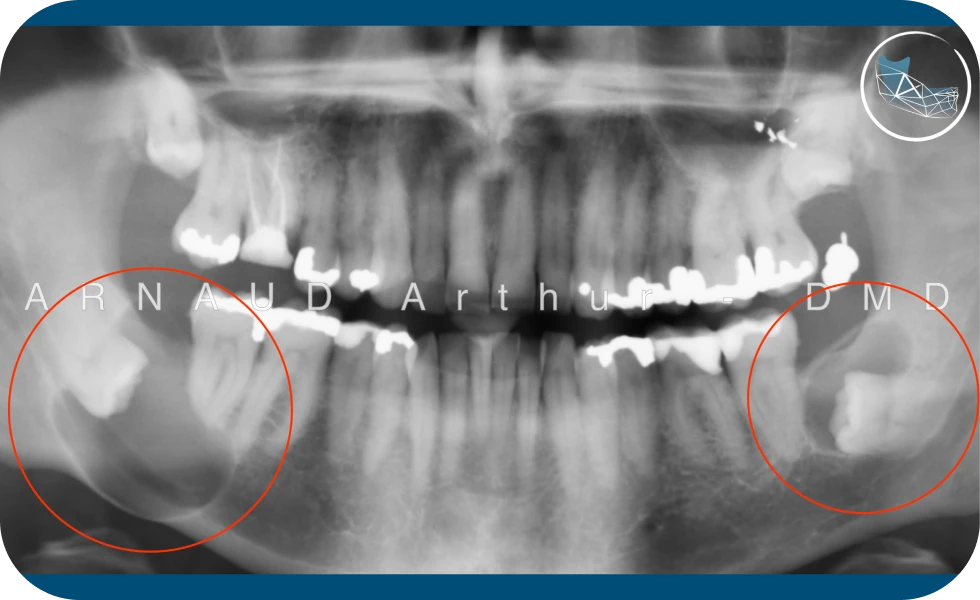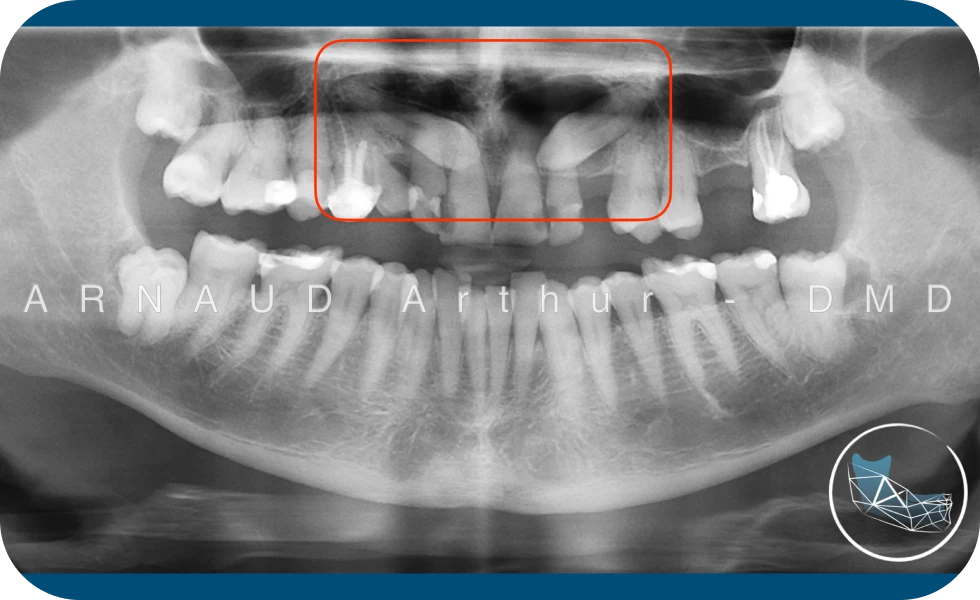Surgery for cysts and benign tumors
Cysts and benign tumors of the jaws are frequent pathologies in Oral Surgery, requiring special attention for early diagnosis and appropriate management. Although these lesions are not cancerous, some can progress rapidly or become more aggressive, causing complications if not treated in time.
What is a jaw cyst?
A cyst is an abnormal, fluid-filled cavity formed from the tissues of the jaw. It often develops silently, and can remain asymptomatic for a long time (most are discovered on panoramic X-rays by chance). Cysts can affect the jawbone (mandible or maxilla), teeth or surrounding soft tissue.
The most common types of cysts include:
- Root cysts: often caused by dental infection or untreated decay that has reached the dental pulp.
- Follicular or dentigerous cyst: surrounds the crown of an unerupted tooth or tooth embedded in bone, usually a wisdom tooth.
- Periodontal cyst: forms around a partially erupted tooth or as a result of periodontal disease.
Cysts, while not malignant, can grow and cause damage to surrounding structures, such as bone resorption, jaw deformation or tooth displacement/resorption.
What is a benign tumour of the jaw?
Unlike cysts, benign tumors are solid growths formed from jaw tissue. They do not spread to other parts of the body, but can nevertheless cause functional or aesthetic problems if they increase in size. The most common benign tumors include :
- Ameloblastoma: One of the most common benign tumors, it tends to be locally aggressive, requiring surgery and rigorous monitoring to prevent recurrence.
- Complex odontomas: the second most common benign tumor. They are made up of tiny unformed teeth inside a cavity (sometimes dozens of them), and can prevent proper positioning of the teeth, especially in adolescents.
Benign tumours can be discovered during routine examinations, such as panoramic X-rays or 3D scans (cone beam) of the jaw. Although non-cancerous, they need to be closely monitored even after surgery, to avoid long-term complications.
What are the signs and symptoms?
These lesions often go unnoticed because they develop painlessly and slowly. However, there are some warning signs:
- Swelling or deformation of the jaw
- Abnormal tooth mobility
- Localized pain, especially when chewing
- Sensation of pressure in the gums or teeth
- Presence of a visible or palpable lump in the mouth
These symptoms should not be overlooked, and require a consultation to establish an accurate diagnosis.
How are cysts and benign tumours treated?
The management of cysts and benign tumors depends on their size, location and nature. Anesthesia options (local or general) may also vary, and will be proposed to you in consultation based on the above criteria.
The main treatment remains surgical and may include:
- Enucleation: This procedure involves removing the entire cyst or tumor, often through intraoral access, thus minimizing visible scarring on the skin.
- Marsupialization: This technique involves creating a permanent opening in a cyst to allow drainage and reduce its size, thus facilitating healing while preserving surrounding structures (nerves, teeth, sinuses, etc.). It is often used to treat large or recurrent cysts. Once the size of the lesion has been reduced, a second operation is performed to remove it.
- Bone resection: In more serious cases, when the tumour is more aggressive or extensive, a portion of the jaw may be removed. This surgery is meticulously performed to preserve the aesthetics and function of the jaw as much as possible.
Once the lesion has been removed, it is sent to the pathology laboratory for analysis and definitive diagnosis.
Annual monitoring with X-rays is necessary to ensure no recurrence.
If you are experiencing unusual symptoms, or if a cyst or benign tumour has been detected during an examination, don’t hesitate to make an appointment for a consultation.

